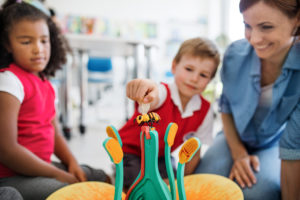- All-In-One Beekeeping for the Bees
- +1-608-728-8233
- info@beepods.com
Teach a Bee Unit

A group of small school kids with teacher sitting on the floor in class, learning science.

Spring is here. Days are getting longer, flowers are blooming, and students (and teachers) are squirming in their seats. Why not break out a new unit to grab their attention? There are some impressive, no-cost beekeeping units online that making learning science fun. Since they are online, it’s easy for teachers to teach a bee unit remotely and share them with their students. Here’s a look at two of them.
Get the Buzz on Honey Bees by Scholastic
Grades: 3-5
Sponsored by DreamWorks Animation and the National Honey Board, this four-lesson unit combines reproducibles featuring “Bee Movie” bees with informative scientific resources. Each of the four lessons has both science and geography standards, printable materials, and step by step directions. Kids will love the Bee Movie graphics, especially if you are able to print in color. If you’re looking for a child-friendly way to teach a bee unit, this is it.
Africanized Honey Bee Education Project
As a response to the arrival of Africanized honey bees in the Southwest, the University of Arizona created lesson plans to help educators teach a unit on honey bees and Africanized bees. Divided into four grade clusters, lessons include stories, poems, activities, games, quizzes, and diagrams. Some materials are not included but could be purchased from a science supply store. While some of the material is specific to Arizona, much of the content would apply to honey bees anywhere. Africanized bees can be found throughout much of the South so many students would benefit from learning more about them.
Grades: K-3
The reproducibles are not slick like Scholastic’s, but what they lack in style they make up for in creativity. Kids get to put together paper bees, play a pollination game, learn a waggle dance, sing songs and read poems. Primary school kids doing waggle dances? What’s not to love?
Grades: 4-6
Once again students make models of bee but this time they are more detailed. To learn about collecting pollen, students sprinkle cooked rice into a hairbrush and then come it out. They build leafcutter bee houses and learn about predators that feed on bees and their honey. Did you know that when a bee stings it gives off an alarm pheromone that smells like bananas? That’s why you should wash your clothes after you are stung.
Grades: 7-8
These are extensions of the younger grade lessons more than stand-alone lessons. Students get to read the diary of an Africanized honey bee, look for mimicry in plants and animals, write a newspaper story about a stinging incident, and learn about beekeeping equipment and the life of a bee.
Grades: 9-12
High school students start their unit by looking at bee misconceptions in science fiction movies. They also conduct an experiment to determine how honey bees perceive colors and shapes and another experiment to see if they can determine the sex of a person by smelling an article of clothing.
Bees are a fascinating topic for students to explore. Schools with beehives and outdoor classrooms especially benefit from including bee curricula across their grade levels.
Resources: https://www.beepods.com/best-top-bar-hive/for-educators/ https://cals.arizona.edu/pubs/insects/ahb/ http://www.scholastic.com/browse/unitplan.jsp?id=283
Bill Polacheck
Latest posts by Bill Polacheck (see all)
- Level Up with a Beekeeping Course - September 15, 2020
- Beepods Harvest Box: Helping Your Bees Survive the Winter - September 8, 2020
- Simple Ways You Can Communicate Like a Bee - September 1, 2020



